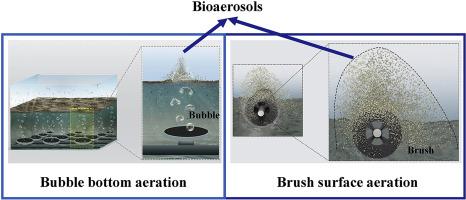Environmental Pollution ( IF 7.6 ) Pub Date : 2020-09-08 , DOI: 10.1016/j.envpol.2020.115571 Yunping Han , Tang Yang , Chao Han , Lin Li , Junxin Liu

|
Given that studies on actual sewage treatment plants are often affected by environmental conditions, it is challenging to clearly understand the associated bioaerosol generation and diffusion characteristics during the aeration process. Therefore, to enhance understanding in this regard, in this study, bioaerosol generator was used to simulate bioaerosol generation and diffusion under two aeration modes, i.e., bubble bottom aeration and brush surface aeration. The total concentration range of culturable bacteria in the bioaerosol produced by bubble bottom aeration and that produced by brush surface aeration were 300–3000 CFU/m3. Under bubble bottom aeration, the generated bioaerosol was symmetrically distributed around the source point, whereas under brush surface aeration, it was primarily distributed in the forward direction of the rotating brush surface. These bioaerosols from bubble bottom aeration predominantly consisted of particles with sizes below 3.3 μm, particularly those with sizes in the range 1.1–2.1 μm. On the contrary, the bioaerosols produced via brush surface aeration predominantly consisted of particles with sizes above 3.3 μm. The distribution characteristics of population structure in the two aeration modes were consistent with the distribution characteristics of concentration in the corresponding models. Additionally, the results showed that when the aeration process is unaffected by environmental conditions (particle matters, wind direct, wind speed, etc.), the bioaerosol components originate primarily from the parent sewage or sludge, and do not diffuse far from the source point. Therefore, source reduction (capping or sealing) can be recommended as the primary control strategy for bioaerosols in sewage treatment plants. The adoption of such measures will significantly limit the diffusion of bioaerosols, thereby reducing the potential risks associated with human exposure.
中文翻译:

两种曝气条件下生物气溶胶的产生与扩散研究
鉴于对实际污水处理厂的研究通常受环境条件的影响,因此要清楚地了解曝气过程中相关的生物气溶胶的产生和扩散特性,具有挑战性。因此,为了增强对此方面的理解,在本研究中,使用了生物气溶胶发生器来模拟生物泡沫在两种情况下的生成和扩散,即气泡底部曝气和刷面曝气。气泡底部曝气和刷子表面曝气产生的生物气溶胶中可培养细菌的总浓度范围为300–3000 CFU / m 3。在气泡底部曝气下,生成的生物气溶胶在源点周围对称分布,而在刷子表面曝气下,其主要分布在旋转刷子表面的正向。这些来自气泡底部曝气的生物气溶胶主要由粒径小于3.3μm的颗粒组成,尤其是粒径在1.1-2.1μm范围内的颗粒。相反,通过刷子表面通气产生的生物气溶胶主要由粒径大于3.3μm的颗粒组成。两种曝气模式下种群结构的分布特征与相应模型中的浓度分布特征一致。此外,结果表明,当曝气过程不受环境条件(颗粒物,直接风,风速等),生物气溶胶成分主要来自母体污水或污泥,并且不会扩散到源头。因此,可以建议减少污染源(加盖或密封)作为污水处理厂中生物气溶胶的主要控制策略。采取此类措施将大大限制生物气溶胶的扩散,从而降低与人类接触相关的潜在风险。









































 京公网安备 11010802027423号
京公网安备 11010802027423号